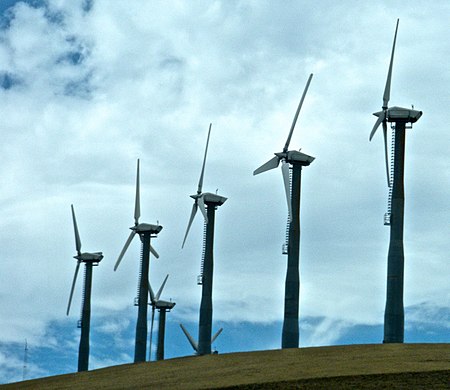Altamont Pass

Altamont Pass, formerly Livermore Pass, is a low mountain pass in the Diablo Range of Northern California between Livermore in the Livermore Valley and Tracy in the San Joaquin Valley. The name is actually applied to two distinct but nearby crossings of the range. The lower of the two, at an elevation of 741 ft (226 m), carries two railroad rights-of-way (ROWs) and Altamont Pass Road, part of the old Lincoln Highway and the original alignment of US 50 before it was bypassed c. 1937. The bypass route travels over the higher summit, at 1,009 ft (308 m), and now carries Interstate 580, a major regional highway heavily congested by Central Valley suburbanization. Of the two railroad lines through the old pass, one is still in use: the ex-Western Pacific line built in 1908 over the pass, which is sometimes known as the Altamont Corridor, now owned by Union Pacific. It carries freight trains as well as the Altamont Corridor Express, which gives its occasional name (ACE) and operates between Stockton, Livermore, Pleasanton, Fremont, and San Jose. The other and older right-of-way was the line built in 1869 with a 1,200-foot-long (370 m) summit tunnel by the original Western Pacific Railroad (1862–1870) as part of the transcontinental railroad. After 1879, when a sea level ferry crossing at the Carquinez Strait replaced the 1869 route, it remained in use for other purposes by the Southern Pacific. In 1984 it was abandoned and deeded to Alameda County by Southern Pacific Railroad in favor of trackage rights on the aforementioned ex-Western Pacific line. From 1966 to 2008, the Altamont Pass area was home to the Altamont Speedway, which became famous as the site of the 1969 Altamont Free Concert, a large outdoor concert featuring The Rolling Stones and marred by violence. The pass is also known for the Altamont Pass Wind Farm, one of the earliest in the United States.
Excerpt from the Wikipedia article Altamont Pass (License: CC BY-SA 3.0, Authors, Images).Altamont Pass
Altamont Pass Road,
Geographical coordinates (GPS) Address Nearby Places Show on map
Geographical coordinates (GPS)
| Latitude | Longitude |
|---|---|
| N 37.745833333333 ° | E -121.65833333333 ° |
Address
Altamont Pass Road 10822
94551
California, United States
Open on Google Maps




